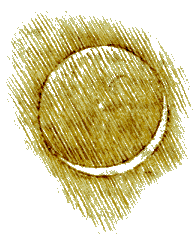Earth shine
Earthlight or earth light is the name given to sunlight that is reflected from the earth into space.
The earth light also reaches the moon on its side facing us. As a result, areas that are not illuminated by the sun are also dimmed here . Light that reaches the earth again as ash-gray moonlight through a further reflection on the surface of the moon can, under favorable observation conditions , reveal parts of the night side of the moon shimmering ashen with the naked eye .
The reflection of the earth's light is best noticeable with a very narrow crescent moon before or after the new moon , provided that the dazzling sun is at a certain angle below the horizon. The poetic description of the old moon in the arms of the young comes from the time before the correct interpretation of this phenomenon .
Details

|
| Away from sunlight through earth light to ash-gray moonlight |
When the moon is new, the moon stands between the earth and the sun, so that one could see the night side of the moon from the earth. But then an observer on earth stands in the light of day. Therefore, a new moon - the night side without a crescent moon - cannot be perceived from the earth's surface (unless a solar eclipse occurs) through the atmosphere illuminated by scattered sunlight .
An observer on the moon could look at the illuminated side of the earth at this time: For him, the earth would stand as "full earth" in the black moon sky and would appear there about three times because of its much larger diameter and also due to clouds, blankets of snow and bright deserts higher reflectivity about fifty times brighter than the full moon when viewed from Earth. When you consider that moonlight can be bright enough to produce clear shadows on earth, you might guess how strongly the glow of full earth illuminates the lunar landscape as earth light. With simple binoculars , even details on the night side of the moon's surface can be seen in the pale shimmer of ash-gray moonlight from Earth.

(around 1506–1510; from the Codex Leicester )
The French astronomer André Danjon developed a practical method for the quantitative measurement of the ash-gray moonlight in the first half of the 20th century . Differences in the reflection of earth light allow conclusions to be drawn about changes in the earth's albedo , such as those primarily caused by changing cloud conditions and snow cover.
The correct interpretation of the ashen-gray moonlight is often attributed to Leonardo da Vinci's - between 1506 and 1510 and available in the Codex Leicester - notes, including Michael Mästlin (1550–1631). Other observers had taken the view that the moon itself emitted some light, or they said that, like water, it is translucent and shines in sunlight.
